Occupational environment monitoring at the factory producing toilets
99,000 ₫
Note: The above price is calculated for one sample. Prices may fluctuate depending on the area of the environment to be monitored and market conditions. For more accurate pricing support, please refer to the price list or contact our consulting staff directly.
Workplace environment monitoring for a toilet manufacturing factory is a session of collecting, analyzing, and evaluating factors at the workplace that may be harmful to workers health.
Table of Contents
Toggle1. Overview of Toilet Manufacturing Factories
a. What is a toilet manufacturing factory?
A manufacturing factory for toilets is a facility specialized in producing and assembling various types of toilets. These factories typically feature production lines and technologies designed to produce toilet products that meet quality and safety standards.
Toilets produced in such factories may include components such as the toilet bowl, water inlet, flush valve, and other accessories. Toilet manufacturing factories usually implement strict quality control procedures to ensure the final products comply with technical requirements and safety standards.

b. Production stages in toilet manufacturing factories
In a toilet manufacturing factory, the production process typically goes through the following stages:
- Material preparation: The factory collects necessary materials such as porcelain, ceramics, minerals, and other components for use in the production process.
- Molding and design: Engineers and designers create toilet models and detailed designs for production. Molds are used to produce accurate replicas of toilets in the casting process.
- Toilet casting: The casting process begins with mold creation. Materials such as porcelain, ceramic, or composite are poured into the molds and then dried or fired to form the shape and structure of the toilet.
- Processing and finishing: Once the toilet is cast, it undergoes processing to cut, polish, and create details such as the flush hole, flush valve, and water inlet. Surfaces may also be polished or glazed to enhance aesthetics and protection.
- Quality control: All finished toilets undergo strict quality inspections to ensure they meet dimensional, quality, and safety standards. This may include water tightness tests, mechanical strength tests, and surface inspections.
- Packing and transportation: After quality checks, toilets are carefully packaged to prevent damage during transportation to retail locations or construction projects.

c. Types of machinery used in toilet manufacturing factories
Various machinery and equipment are used to support the production process in toilet manufacturing factories. Some common machines include:
- Toilet casting machines: Used to cast toilets from materials such as porcelain, ceramic, or composite. These can be automated or manual machines depending on production scale and technology.
- Processing machines: These machines perform processing and finishing tasks after casting, including cutting, grinding, drilling, and polishing to create features like flush holes, flush valves, and smooth surfaces.
- Glazing machines: Apply a protective and decorative glaze to the toilet surface, usually involving spraying the glaze followed by firing in a kiln to bond the glaze.
- Quality inspection machines: Check parameters such as water tightness, mechanical strength, and surface defects. Equipment may include pressure testing machines, strength testers, and surface scanners.
- Packing machines: Used to package finished toilets for transportation. These may include heat-sealing, plastic bag, or carton box packing machines.
- Transport and lifting equipment: Forklifts, cranes, and conveyor systems are used to move and reposition products within the factory.

d. Occupational diseases in toilet manufacturing factories
Workers in toilet manufacturing factories may encounter the following occupational diseases:
- Respiratory diseases: Industrial environments may involve air pollution, dust, chemical vapors, and other irritants, potentially causing asthma, bronchitis, pneumonia, and other respiratory problems.
- Skin diseases: Continuous exposure to chemicals and materials during production can lead to dermatitis, burns, skin irritation, and infections.
- Spinal and musculoskeletal disorders: Heavy lifting, awkward postures, and strenuous activity may cause spinal and joint issues, including disc degeneration, back pain, arthritis, and injuries.
- Mechanical injuries: Working with machines and tools carries risks of cuts, abrasions, and impact injuries.
- Noise and temperature-related illnesses: Certain production processes generate high noise levels, which can damage hearing. Working in extreme temperatures may cause thermal stress and other health problems.
To ensure worker health and safety, adherence to labor protection measures, proper use of personal protective equipment, regular medical monitoring, and compliance with safety procedures are essential in production environments.

e. Common types of toilets on the market
There are many popular toilet types with diverse features and designs available in the market. Some common types include:
- Standard two-piece toilets: The most widely used type, consisting of a bowl and a tank. Available in various designs, sizes, and colors.
- Wall-hung toilets: Mounted directly on the wall with no floor support, creating open space and easier cleaning underneath. These typically feature modern, sleek designs.
- Dual-flush toilets: Equipped with two flush options—light and strong—allowing water-saving operation.
- Water-saving toilets: Designed to use less water than conventional toilets, employing technologies such as dual-stage flushing, extended flush, or vacuum flush.
- Smart toilets: Integrated with advanced features such as automatic flushing, adjustable water temperature and pressure, drying, self-cleaning nozzles, deodorization, and remote control.
- High-efficiency toilets: Comply with water-saving and high-performance standards, offering effective flushing while conserving water.
2. Overview of occupational environment monitoring services
a. What is occupational environment monitoring at a toilet manufacturing factory?
Occupational environment monitoring (or workplace environment measurement) at a toilet manufacturing factory involves collecting, evaluating, and analyzing measurements of workplace environmental factors. The purpose is to take timely measures to minimize environmental harm to workers’ health and prevent occupational diseases. Such monitoring is mandatory for toilet manufacturing factories.
Occupational environment monitoring is crucial for maintaining, protecting, and improving worker health, as employees are the main resource generating profit for a company. Workers exposed to risk factors or occupational hazards exceeding allowable limits may suffer health impacts and develop occupational diseases.
REGISTER FOR OCCUPATIONAL ENVIRONMENT MONITORING SERVICE
b. Nam Viet’s occupational environment monitoring program
Nam Viet’s occupational environment monitoring program is developed by monitoring engineers specializing in occupational safety and environmental protection. Aiming to ensure worker health and safety, the program uses modern measurement techniques to monitor air, water, and microclimate, physical, and dust factors in the workplace. This program is vital for maintaining a safe work environment and protecting employees’ health.
Additionally, Nam Viet’s monitoring program plays a key role in researching and developing new solutions to improve workplace environmental quality. With a dedicated and professional team of experts, Nam Viet’s exclusive monitoring program represents a breakthrough in occupational safety and environmental management in Vietnam.

c. Standardization in workplace measurement procedures
Standardization in Nam Viet’s workplace measurement procedures ensures the quality and reliability of results. To guarantee accuracy, the program follows recognized standards and procedures from the Ho Chi Minh City Department of Health. This ensures that collected data is highly reliable for evaluating workplace conditions and making decisions to improve employee health and safety.
These standardized procedures also ensure that measurements are conducted by highly qualified monitoring professionals with extensive experience, allowing managers and experts to trust An Toan Nam Viet’s results and make accurate decisions to protect employee health and the environment.
By applying standardization, Nam Viet demonstrates its commitment to ensuring a safe work environment and contributes to improving occupational safety and environmental management quality in Vietnam.
d. Reporting occupational environment monitoring results for toilet manufacturing factories
Monitoring results are prepared according to Form No. 04, Appendix III issued with Decree 44/2016/ND-CP and prepared in two copies: one sent to the contracting workplace and one retained by the monitoring organization.
Records must be maintained indefinitely according to legal regulations.

e. Frequency of occupational environment monitoring as per legal regulations
According to Clause 2 of Article 18 of the Law on Occupational Safety and Hygiene 84/2015/QH13, employers must organize workplace environment monitoring to evaluate harmful factors at least once a year.
f. Deadlines for submitting monitoring results as per legal regulations
Reports must be submitted before December 31 each year. Enterprises must submit monitoring results to the local Department of Health where the business is headquartered and where employees are working.
When changes occur in production technology, processes, or facility upgrades that may introduce new occupational hazards, enterprises must update occupational hygiene records to include newly identified harmful factors requiring monitoring.
g. Penalties for violations of occupational environment monitoring by employers
According to Article 27 of Decree 12/2022/ND-CP dated January 17, 2022, regarding administrative penalties in labor, social insurance, and Vietnamese workers working abroad under contract:
- Clause 2: Fine of 2,000,000 – 5,000,000 VND for employers who fail to publicly disclose monitoring results to employees at the monitoring site and other relevant locations immediately after the results are available.
- Clause 3: Fine of 20,000,000 – 40,000,000 VND for employers who fail to conduct occupational environment monitoring to control health risks to employees as required by law.
- Clause 4: Fine of 40,000,000 – 60,000,000 VND for employers who collaborate with monitoring organizations to commit fraud in monitoring activities, without reaching the level of criminal liability.
3. Harmful environmental factors for workers in toilet manufacturing factories
Workers in toilet manufacturing factories may be exposed to several harmful environmental factors that can affect their health. The following are some common hazards in such workplaces:
- Dust and fine particles: The production process of toilets can generate dust and fine particles from materials such as porcelain, ceramics, composites, or chemicals. Inhaling dust and fine particles can cause respiratory irritation, pneumonia, and other health issues.
- Chemicals: During toilet production, chemicals such as solvents, cleaners, adhesives, glazes, and dyes may be used. Exposure to these chemicals can irritate the skin, eyes, nose, throat, and lungs. If not used and handled properly, long-term exposure to chemical compounds can result in serious health consequences.
- Noise: Some production processes can generate high noise levels from machinery, tools, or processing equipment. Prolonged exposure to noise without adequate ear protection can cause hearing problems and stress, affecting workers’ health and mental well-being.
- Temperature and humidity: Toilet manufacturing factories may have high temperature and humidity due to production processes or poor working conditions. This can lead to fatigue, dehydration, heat stress, and discomfort for workers.
- Occupational safety risks: Workers may face risks of accidents from machinery, sharp equipment, heavy materials, collisions, or slips and falls. These incidents can cause serious injuries such as cuts, lacerations, fractures, and burns.
REGISTER FOR OCCUPATIONAL ENVIRONMENT MONITORING SERVICE
4. Measures to improve working conditions in toilet manufacturing factories
To improve working conditions in toilet manufacturing factories and ensure workers’ health and safety, the following measures can be implemented:
- Ensure ventilation and exhaust systems: Provide effective ventilation systems and exhaust fans to remove dust, chemical vapors, and other pollutants from the workplace. This reduces the risk of inhaling harmful substances and improves air quality.
- Use personal protective equipment (PPE): Ensure workers are equipped with appropriate PPE such as masks, gloves, safety goggles, chemical-resistant clothing, and safety shoes. This helps protect the skin, eyes, and respiratory system and minimizes exposure to harmful substances.
- Training and education: Provide occupational safety and protection training for workers. Ensure they understand environmental hazards and know how to use PPE correctly. Education on safety, work procedures, and risk management should also be conducted.
- Control temperature and humidity: Ensure a comfortable and safe working environment by regulating temperature and humidity. Use air conditioning or other measures to maintain optimal conditions in the factory.
- Noise control: Implement measures to reduce noise in the workplace. This can include soundproofing, ear protection, or using quieter equipment.
- Waste management: Ensure that waste from toilet production is handled according to environmental regulations. Limit unsafe discharge to protect the environment and human health.
- Periodic inspection and maintenance: Conduct regular inspections and maintenance of equipment, machinery, and systems in the factory to ensure efficient operation, prevent accidents, and reduce risks to workers.
- Periodically conduct occupational environment monitoring in factories, collecting and analyzing harmful factors affecting workers, and adjusting measures to reduce hazards and prevent occupational diseases.
5. Benefits of periodic monitoring in toilet manufacturing factories
An Toan Nam Viet provides businesses with excellent advantages when using occupational environment monitoring services in accordance with Decree 44/2016/ND-CP on the management and control of harmful workplace factors affecting employees.
- Businesses can proactively control harmful factors in workshops or factories.
- Receive advice and recommendations on measures to minimize harmful factors and improve working environment quality.
- Indirectly protect human resources, a key factor in business development.
- Reduce the harmful impact of occupational diseases on health, thereby minimizing future treatment costs.
- Improve worker health, ensuring product quality and maintaining production output.
- Ensure compliance with labor safety laws and avoid legal risks.
- Enhance credibility and professionalism in all aspects, elevating the company’s brand.
Nam Viet’s environmental monitoring service is a solution to reduce occupational disease risks, contributing to a clean and high-quality working environment.

6. National occupational environment monitoring center
Occupational environment monitoring center of Nam Viet is a professional unit specializing in monitoring and measuring workplace environmental quality across all provinces in Vietnam. With a team of experienced monitoring specialists, the center uses modern measurement equipment to ensure accuracy and reliability.
In addition to monitoring services, the center assists clients in planning, managing, and tracking occupational environmental issues. With the motto “customer-centered,” the center prioritizes customer satisfaction, meets all client needs, and is committed to providing the best solutions for businesses.
REGISTER FOR OCCUPATIONAL ENVIRONMENT MONITORING SERVICE
With investments in technology, equipment, and human resources, Nam Viet’s monitoring center has become one of the most reputable units in occupational environment monitoring in Ho Chi Minh City, with the following objectives:
- We always value our brand reputation and the quality of our services.
- We provide clients with the best and most suitable solutions possible.
- Alongside a team of experienced Masters and Engineers, committed to environmental protection and business benefits.
- At Nam Viet Environmental Monitoring, companies receive professional service from experts in the monitoring field, along with the best cost advantages.
The occupational environment monitoring process at Nam Viet includes the following basic steps:
- Before conducting monitoring, our company ensures all equipment is calibrated according to legal regulations.
- Follow the occupational environment monitoring procedures committed to the Department of Health accurately and fully.
- Report monitoring results honestly to employers.
- If monitoring results indicate unsafe conditions, Nam Viet provides corrective solutions, and the workplace implements the following:
- Implement measures to improve working conditions, minimize harmful factor impacts, and prevent occupational diseases.
- Conduct health examinations to detect occupational and related diseases early for workers in unsafe environments.
- Provide in-kind compensation to workers according to labor law.

7. Occupational environment monitoring quotation
To help businesses conduct professional and effective occupational environment monitoring, Nam Viet provides clients with a quotation for occupational environment monitoring services that is high-quality and reasonably priced.
- Our quotation provides detailed pricing information for the monitoring services we offer, including costs related to travel, measurement, analysis, and reporting. Clients can trust the accuracy and reliability of the monitoring reports we provide.
- We commit to offering competitive and reasonable prices in the market and are always ready to provide quick and professional advice for any inquiries regarding monitoring services.
- With Nam Viet’s monitoring quotation, clients can easily select service packages suitable to their needs. We are committed to delivering the highest satisfaction with professional service quality.
No comments yet

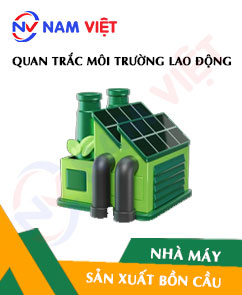
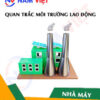
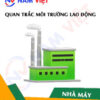


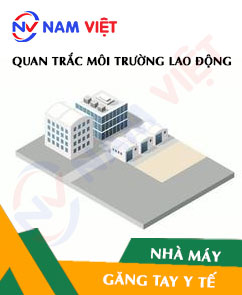


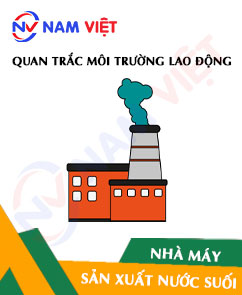


Review Occupational environment monitoring at the factory producing toilets
There are no reviews yet.